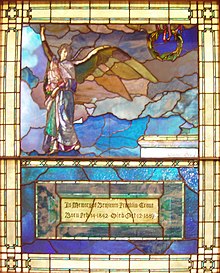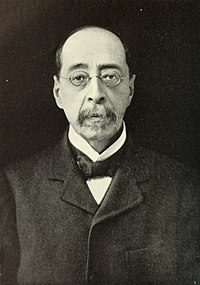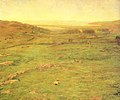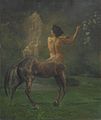John La Farge (artist)
John La Farge (born March 31, 1835 in New York City , United States , † November 14, 1910 in Providence, Rhode Island ) was an American painter , interior designer and art historical non-fiction author.
Life and education
La Farge was one of several sons of wealthy French parents and was raised bilingually. As a child, he and his brothers published the French-language magazine Le Chinois . During his studies at Mount St. Mary's University in Emmitsburg, Maryland and at Fordham University in New York, he became interested in art. He gave up his plans to study law after visiting Paris in 1856 and seeing the art scene there; instead he studied with Thomas Couture and got to know well-known intellectuals. La Farge also took courses with William Morris Hunt in Newport, Rhode Island .
Private life
La Farge married his wife Margaret Mason Perry (1839-1925) in Newport on October 15, 1860, whose father was a descendant of Thomas Prence , who had co-founded Eastham, Massachusetts and was governor of Plymouth Colony several times in the 17th century . Margaret's paternal ancestors also included William Brewster , one of the passengers on the Mayflower . Her maternal grandparents were Sarah Franklin Bache and Richard Bache , making her the great-great-granddaughter of Deborah Read and Benjamin Franklin . Her brother Thomas Sergeant Perry taught at Harvard University and was married to the artist Lilla Cabot Perry .
The couple had a total of eight children, seven of whom reached adulthood. The eldest son, Christopher Grant La Farge, was a partner in the New York architecture firm Heins & LaFarge . He was responsible for projects of Beaux Arts architecture and designed, among other things, the Byzantine Cathedral of Saint John the Divine in New York, the now defunct building of the connection St. Anthony Hall in Yale and the original Astor Court building of the Bronx Zoo . His sons include the writer Christopher La Farge and the anthropologist Oliver La Farge .
John La Farge's daughter Frances Aimee and her husband Edward H. Childs had their daughter Frances Sergeant Childs , who was one of the founders of Brooklyn College , where she taught history.
Oliver Hazard Perry La Farge also worked as an architect, including partnering with Marshall Latham Bond , and designed the Perry Building in Seattle , which still exists today . Later he mainly designed company buildings for General Motors .
The youngest son John La Farge was Jesuit - priests and a strong advocate of anti-racist reforms.
John La Farge died in 1910 at Butler Hospital in Providence, Rhode Island, and was buried in Green-Wood Cemetery , Brooklyn . His records are now in the holdings of the Yale University Library .
Professional activity

Already in his first own work, which he produced in Newport, his own signature is evident, especially with regard to the color design. He created many of his mythological and religious paintings - including the work Virgil - in a forest in a region of Rhode Island known as "Paradise". La Farge was one of the first painters to deal with Japanese art; many of his works show a corresponding influence. He mainly worked in a studio at 51 West 10th Street in Greenwich Village , which is now part of the campus of Eugene Lang College of New School University .
Between 1859 and 1870 he illustrated the ballad Enoch Arden by Alfred Tennyson and the volume of poetry Men and Women by Robert Browning . In the 1870s, La Farge began making muralisms , which at that time were particularly popular in public buildings and churches. His first work of this kind was a wall painting created in 1873 in the Trinity Church in Boston , later works in the Church of the Ascension, Episcopal ( Manhattan ) and St. Paul's Chapel at Columbia University followed . At the age of 71, he created four large bezels for the Minnesota State Capitol , the images of which represent legal history. He made a similar series for the State Supreme Court building in Baltimore . In addition to public works, he also took on private work, including an order from Cornelius Vanderbilt, which amounted to around 100,000 US dollars (now approx. 2,628,000 dollars) in 1883 .
La Farge made extensive trips to Asia and the South Pacific to get inspiration for his painting. In 1886 he visited Japan , in 1890 and 1891 Polynesia followed , where he especially studied the culture of Tahiti . On his travels he was regularly accompanied by Henry Adams . In September 1890, La Farge reached Hawaii , where he painted the landscapes of Oahu and an active volcano on the island of Hawaii .
In 1892 he worked at the Metropolitan Museum of Art Schools as a professional teacher for New York art students. From 1899 to 1904 he was President of the National Society of Mural Painters .
La Farge was proficient in a variety of ancient and modern languages and had extensive knowledge of literature and art. Although he questioned many things, he kept the traditions of religious art and also held on to his Catholic faith.
Stained glass
La Farge experimented a lot with colors and their application in glass painting . He relied on the models of medieval window designs, developed his own methods for layering and fusing the glass parts and added new design aspects such as opalescence . Opalescent glass had been known for centuries for making dinnerware , but was first formed into flat pieces by La Farge that could be used as window panes or other decorative objects. He worked closely with a glass factory in Brooklyn. In the mid-1870s, La Farge showed the result of his experiments to Louis Comfort Tiffany , who was very interested in the new technology. Only a few years later there was a patent disputes between the two men.
On November 10, 1879, John La Farge applied for a patent for his developments shortly after a newspaper article reported on his latest work for Richard Derby as "the first use of a new material (opalescent glass) in window production". The patent was granted with the number 224,831 on February 24, 1880 and contained technical information for the production of opalescent glass and its layering for the production of window panes. Eight months later, Tiffany filed a very similar patent, which was awarded to him in 1881 under number 237,417. Essentially, the two patents differ in technical details, e.g. with regard to the air gap between two layers of glass. Since the La Farge patent focused on the material and the Tiffany patent focused more on manufacturing processes, neither artist could make such windows without getting permission from the other. It is not scientifically clear whether and in what form there were agreements between La Farge and Tiffany for mutual patent use. What is certain, however, is that La Farge planned in 1882 to sue Tiffany for infringement of his patent. Since there are no court records on such a case, there is very likely no actual trial, but there are numerous references to this dispute in the surviving letters of both artists. It is believed that due to the increasing popularity of opalescent glass and the growing interest of other artists, they decided not to legally enforce their patent claims.
John La Farge made a wide variety of windows including:
- Trinity Church (Boston) (1877-78)
- Biltmore Estate in Asheville , North Carolina (1881)
- Church of St. Joseph of Arimathea in Greenburgh , New York (1883)
- Unity Church in North Easton, Massachusetts (1882)
- St. Paul's Chapel , Columbia University , NYC (1888–99)
- First Unitarian Church of Detroit (1890)
- First Unitarian Church of Philadelphia (1891)
- Trinity Episcopal Church in Buffalo , New York (1886-89)
- All Saints Episcopal Church , Briarcliff Manor , New York (1889)
- Church of the Transfiguration, Episcopal , New York City (1898)
- Mount Vernon Church , Boston , 1890s
- Our Lady of Mercy Chapel at Salve Regina University in Newport, Rhode Island
- Christ Church in Lincoln, Rhode Island
- Cathedral of All Saints , Albany , New York
- Thomas Crane Public Library
Several of his windows, including Peonies Blown in the Wind (1880), are now in the collection of the Metropolitan Museum of Art .
Paintings (selection)
Wreath of Flowers , 1866, Smithsonian American Art Museum
Centauress , ca.1887
Kilauea, Looking at Cone of Crater , 1890, Honolulu Museum of Art
Study of Afterglow from Nature (Tahiti: Entrance to Tautira Valley) , 1891, Princeton University Art Museum
Diadem Mountain at Sunset, Tahiti - Brooklyn Museum
Cover art for the serial novel The Turn of the Screw in Collier's Weekly , 1898
Awards
John La Farge was awarded the Knight's Cross of the Legion of Honor (Chevalier de la Légion d'Honneur) by the French government . In 1868 he was inducted into the National Academy of Design , from 1889 to 1904 he was the elected president of the National Society of Mural Painters , and in 1904 he was among the first seven members of the American Academy of Arts and Letters . John La Farge is on 16 December, together with Ralph Adams Cram and Richard Upjohn in calendar of saints of the Episcopal Church .
In pop culture
"John La Farge" is a minor character in the novel The Hearth and Eagle by Anya Seton .
literature
- Own works (selection)
- John La Farge: The American Art of Glass . JJ Little, New York, OCLC 228695735 .
- John La Farge: Considerations on Painting . Reprint Services Corp, 2007, ISBN 978-0-7812-3681-2 (Original title: Considerations on Painting . New York 1895.).
- John La Farge: An Artist's Letters from Japan . Scholar Select, 2015, ISBN 978-1-298-52251-1 (Original title: An Artist's Letters from Japan . New York 1897.).
- John La Farge: The higher life in art. A series of lectures on the Barbizon School of France inaugurating the Scammon course of the Art Institute of Chicago. London 1908, OCLC 265436366 .
- John La Farge: Gospel story in art . Nabu Press, 2010, ISBN 978-1-176-34019-0 (Original title: Gospel story in art . New York 1913.).
- Secondary literature (selection)
- James L. Yarnall, John La Farge: John La Farge, a biographical and critical study . Ashgate, Burlington, VT 2012, ISBN 978-1-4094-1172-7 .
- Royal Cortissoz: John la farge, a memoir and a study . Rarebooksclub, 2012, ISBN 978-1-152-35358-9 (Original title: John la farge, a memoir and a study . Boston 1911.).
- Frank Jewett Mather, Jr .: John La Farge - An Appreciation . In: The World's Work . Vol. XXI, April 1911, pp. 14085–14100 ( limited preview in Google Book search).
- Cecilia Waern: John La Farge artist and writer . Seeley and Co., London 1896, OCLC 20600270 .
Web links
- Literature by and about John La Farge in the WorldCat bibliographic database
- Works by John La Farge in Project Gutenberg ( currently not usually available for users from Germany )
- La Farge Gallery at MuseumSyndicate
- Exhibition catalog of the Metropolitan Museum of Art
- John La Farge Stained Glass in New England: A Digital Guide (Boston College Libraries)
Individual evidence
- ^ A b c Norma J. Roberts et al .: The American Collections . Columbus Museum of Art , Columbus, New York 1988, ISBN 0-918881-20-X , pp. 26 (English).
- ^ A b c John La Farge: The Manner Is Ordinary . Harcourt, Brace, New York 1954, OCLC 599938222 , pp. 28, 34 (English).
- ^ Margaret C. Conrads: American paintings and sculpture at the Sterling and Francine Clark Art Institute . Hudson Hills Press, New York 1990, ISBN 1-55595-050-7 , pp. 115 (English, limited preview in Google Book search).
- ↑ James L. Yarnall: A Beautiful Child and a Portrait Commission Gone awry: The Richard Morris Hunts and John La Farge . In: The American Art Journal . Vol. 29, No. 1/2. Kennedy Galleries, Inc., New York 1998, OCLC 494626878 , p. 86-96 , doi : 10.2307 / 1594620 , JSTOR : 1594620 (English).
- ↑ James L. Yarnall, John La Farge: John La Farge, a Biographical and Critical Study . Ashgate Publishing, Ltd., Farnham, Surrey, Burlington 2012, ISBN 978-1-4094-1172-7 , pp. 50 (English, limited preview in Google Book search).
- ^ John Howard Brown: Lamb's Biographical Dictionary of the United States: Newton-Sears . James H. Lamb Company, Boston 1903, OCLC 609199585 , p. 224 (English, limited preview in Google Book search).
- ^ Yale's Lost Landmarks. (No longer available online.) In: Yale Alumni Magazine. Yale University, p. 22 , archived from the original on February 27, 2007 ; accessed on May 9, 2017 (English).
- ^ The Newport Mercury , June 16, 1900 issue.
- ^ Obituaries October 1910-1911 . In: American Federation of Arts (Ed.): American Art Annual . Vol. 9. MacMillan Co., New York 1911, OCLC 4789923 , pp. 314 (English, limited preview in Google Book search).
- ↑ La Farge Family Papers (MS 24) Manuscripts and Archives, Yale University Library (English)
- ^ Theodore E. Stebbins, Kimberly Orcutt, Virginia Anderson: American paintings at Harvard. Paintings, Watercolors, Pastels, and Stained Glass by Artists Born 1826-1856 . Ed .: Harvard Art Museums. Harvard Art Museums, Cambridge, New Haven 2008, ISBN 978-0-300-12239-8 , pp. 189 (English).
- ↑ Kenneth T. Jackson: The encyclopedia of New York City . Ed .: The New-York historical Society. Yale University Press, New Haven, New York 1995, ISBN 0-300-05536-6 , pp. 650 (English).
- ^ Art, Music and the Drama . In: The Week: a Canadian journal of politics, literature, science and arts . Vol. 2, Issue 1, December 13, 1883, pp. 26 (English, archive.org [accessed on May 9, 2017]).
- ^ David W. Forbes: Encounters with paradise: views of Hawaii and its people, 1778-1941 . Ed .: Honolulu Academy of Arts. Honolulu 1992, ISBN 0-937426-16-4 , pp. 201-220 (English).
- ↑ Aleksandr Gelfand: Finding aid for Schools of The Metropolitan Museum of Art Records (1879–1895). (PDF) The Metropolitan Museum of Art Archives, June 5, 2013, accessed May 9, 2017 .
- ↑ National Society of Mural Painters ( Memento of the original from October 15, 2018 in the Internet Archive ) Info: The archive link was inserted automatically and has not yet been checked. Please check the original and archive link according to the instructions and then remove this notice.
- ^ A b Julie L. Sloan: The Rivalry Between Louis Comfort Tiffany and John La Farge. Retrieved May 9, 2017 .
- ^ Robin Neely: Two Masterpieces: La Farge Windows in North Easton, Massachusetts . In: Stained Glass Association of America (Ed.): Stained Glass . Quarterly of the Stained Glass Association of America. Vol. 102, No. 1 , 2007, ISSN 0038-9161 , p. 40–64 (English, sgaaonline.com [PDF; accessed on May 9, 2017]).
- ↑ Julie L. Sloan, James L. Yarnall: Art of an Opaline Mind: The Stained Glass of John La Farge . In: Kennedy Galleries, Inc. (Ed.): The American Art Journal . Vol. 24, No. 1/2. New York 1992, OCLC 494626878 (English).
| personal data | |
|---|---|
| SURNAME | La Farge, John |
| BRIEF DESCRIPTION | American painter, interior designer, and art historian |
| DATE OF BIRTH | March 31, 1835 |
| PLACE OF BIRTH | New York City , United States |
| DATE OF DEATH | November 14, 1910 |
| Place of death | Providence, Rhode Island |


















